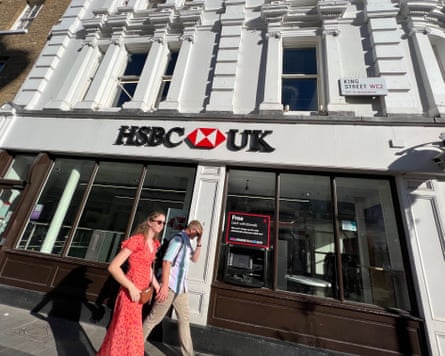Many of us frequently shop around for the best insurance deals or supermarket offers but forget about their bank account – and it could be leaving you hundreds of pounds worse off.
Here are five the most common banking mistakes and how to avoid them.
Thinking that loyalty pays
HSBC, Lloyds, NatWest and Barclays dominate the current account market in the UK, and are responsible for three-quarters of accounts. However, none of the big four are rated in the top five for service, says Alastair Douglas, the chief executive of the credit app TotallyMoney, referring to a survey of customers by the Competition and Markets Authority (CMA).
Sticking with a trusted brand or perhaps a bank you have been with since childhood may seem like the safe option, but you could be missing out.
An array of new challenger banks offer slick apps, top savings rates, and handy features that make it easier to split a bill or divvy up your savings. Respondents to the CMA survey ranked Chase, Monzo and Starling as top for “overall service quality”.
Almost 1.2 million people switched bank last year, according to payments network Pay UK, with online or mobile banking (46%) the top reason they preferred their new account, followed by the interest they earned (37%) and customer service (32%).
Switching bonuses can also make opening a new account worth it. Current deals include £175 free cash to those who switch to First Direct and £150 for those who move to NatWest. Be sure to check the terms and conditions – some accounts require a minimum monthly deposit or a certain number of direct debits to qualify.
Switching is easy: provide your old account details to your new bank and it will do the legwork, including transferring any direct debits. Under the Current Account Switching Service guarantee, the whole process should only take seven working days.
Do your homework first. Check reviews and make sure the bank is a member of the Financial Services Compensation Scheme, which protects up to £85,000 of your money if your bank fails.
Using your overdraft
The overdraft attached to your current account may seem convenient, but use it at your peril as it is typically one of the most expensive ways to borrow money.
Some people assume that having an “arranged overdraft” means they can go overdrawn without penalty, but this is not the case. The typical overdraft rate ranges from 35% to 50%, according to TotallyMoney, and about 9.7 million people are overdrawn by an average of £709 every month.
Running a £709 overdraft at a rate of 39.9% would rack up £283 in interest charges over 12 months, says Andrew Hagger, the founder of the financial website MoneyComms.
A better option may be to use a 0% credit card. These let you clear your debt over a set period, without accruing further interest charges. You need to look for a money transfer card, not a balance transfer card.
A money transfer card lets you effectively give yourself a loan by moving a credit card balance to your current account, where it can be used to clear an overdraft.
Some cards charge a fee for transferring the initial balance, but this is still likely to work out cheaper in the long run.

Tesco Bank’s money transfer card has a rate of 0% for 14 months and has a 3.99% fee. Using it to transfer £709 to clear an overdraft would cost £28.28 – a saving of £254.72 compared with the potential overdraft interest, as long as you pay it off within 14 months.
Use an eligibility checker to see whether you are likely to be approved for a credit card before you apply to avoid affecting your credit score – you can find these on comparison websites such as Comparethemarket and Uswitch.
Hagger suggests asking your bank to reduce your overdraft limit to a nominal amount of about £200 to £300 to reduce the temptation to use it.
Consider using savings to clear your negative balance on your current account. The interest on debt will build up faster than any savings interest, so it makes sense to tackle the overdraft first.
Overfull current account
It is heartening to see a healthy balance, but leaving too much cash in your current – or any other account – is a mistake if it earns little or no interest.
The Bank of England estimates that £280bn is sitting in accounts earning nothing. Any cash in a zero-interest account is not only missing out on interest, it is actually losing value in real terms as inflation chips away at it.

“Switching just £2,000 from a zero-interest account to an easy-access account paying 4.5% would earn you £90 in interest over a year,” says Hagger. “On a £5,000 balance, you would earn £225.”
Experts typically advise having three to six months’ worth of outgoings at hand, but that does not have to mean in your current account. The top easy-access accounts now pay 4.5% or more, and let you withdraw your money at any time.
Use comparison websites such as Moneyfacts to find the best deals and check for any restrictions. Some accounts require 30 days’ notice or allow only a certain number of withdrawals each year. Douglas says the smaller banks may offer more competitive rates as they look to win new customers.
Not reading the small print
Often the savings accounts with the most eye-catching rates are not offering as much as it may first appear.
Anna Bowes, the head of communications at the financial advisers The Private Office, points to Santander’s Edge saver account as one example. It pays a market-leading 6%, but only on balances up to £4,000 – the average saver has more than £17,000 in their account, according to TotallyMoney.
Someone who maxed out the account would earn £240 in interest over a year. You also need an Edge current account to qualify, which costs £3 a month.
Meanwhile, Atom Bank’s easy-access Instant Saver Reward account pays 4.75% on balances up to £100,000, according to Moneyfacts. Someone with the average savings balance of £17,000 could earn £807.50 over a 12-month period.

Regular saver accounts also offer top rates, but only let you set aside a certain amount each month. While these accounts are great for those starting a savings habit, those able to put away larger sums could do better elsewhere.
For example, First Direct’s regular saver pays 7% on up to £300 a month. Those paying in the maximum would have saved £3,600 after 12 months and earned interest of £136.50.
However, if you were able to save £3,600 in full at the start of the year into the Atom Bank account, you would earn £171 – an extra £34.50.
Packaged bank account
Packaged current accounts charge a monthly fee and offer perks such as travel insurance, gadget cover and cashback – but they are only good value if you use the benefits.
For example, the Virgin Money Club M account costs £12.50 a month (£150 a year) and offers family travel and gadget insurance, plus UK and European breakdown cover. MoneySavingExpert estimates that buying the equivalent cover separately could cost up to £500.

But your gadgets may already be covered under your home insurance, or perhaps you do not holiday overseas enough to benefit from the travel insurance. Check what you are paying for and whether it is worth the cost.
“The bottom line is that packaged accounts make banks a lot of money,” Douglas says. “You might be better off picking and choosing the parts that work for you and paying for them separately.”
He adds: “Read the small print to see if the phone insurance includes theft or whether the travel insurance covers the destinations you are planning to visit. You might find out that what initially sounded like a great offer, actually is not.”
Some account requirements quickly get complicated. For example, the Club Lloyds Silver account costs £11.50 a month if you deposit at least £2,000 monthly, otherwise you will pay an extra £3. Or you could get a discount of £2 a month, if you deposit £4,300 a month, or £5,500 for a joint account. Have you got all that?

.png) 3 months ago
52
3 months ago
52

















































